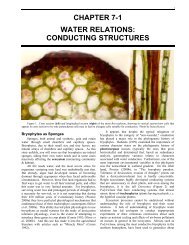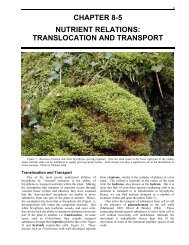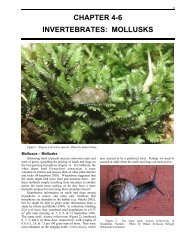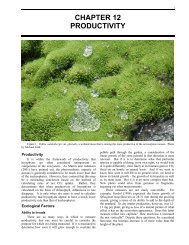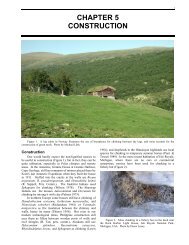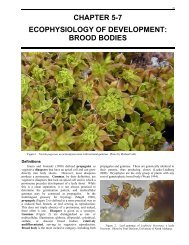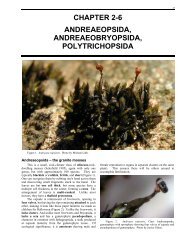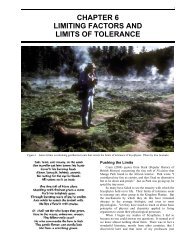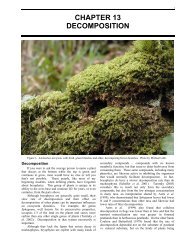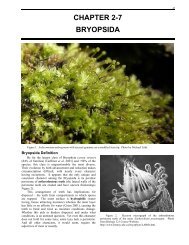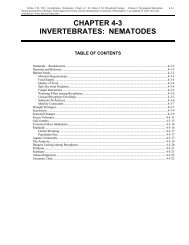Chapter 4-5: Adaptive Strategies - Bryophyte Ecology
Chapter 4-5: Adaptive Strategies - Bryophyte Ecology
Chapter 4-5: Adaptive Strategies - Bryophyte Ecology
You also want an ePaper? Increase the reach of your titles
YUMPU automatically turns print PDFs into web optimized ePapers that Google loves.
40 <strong>Chapter</strong> 4-5: <strong>Adaptive</strong> <strong>Strategies</strong>: Growth and Life Forms<br />
Figure 5. Protonema mosses. Upper: Pogonatum aloides.<br />
Lower: Buxbaumia aphylla. Photos by Michael Lüth.<br />
The same species may exhibit more than one growth<br />
form. For example, in some populations Hylocomium<br />
splendens (Figure 6) exhibits monopodial growth (single<br />
central axis with apical growth) (Ross et al. 1998, 2001).<br />
However, some populations can continue by sympodial<br />
growth (growth produced by lateral buds just behind apex).<br />
In forest habitats of temperate to mid-arctic regions the<br />
growth is primarily sympodial, creating the stair-step form<br />
that easily delineates annual growth (Ross et al. 2001).<br />
Higher nutrient availability promoted sympodial growth.<br />
In tundra and high arctic habitats, monopodial growth<br />
predominates and increments cannot easily be discerned.<br />
Transplant experiments demonstrated that these traits were<br />
plastic, but that natural variability was greater among those<br />
shoots in natural populations at transplant sites, indicating a<br />
genetic component as well as an environmental component<br />
to the differences, affecting both growth and life forms.<br />
Figure 6. Weft life form of Hylocomium splendens. Photo<br />
by Michael Lüth.<br />
Ross et al. (1998) found that the sympodial<br />
Hylocomium splendens plants had increasing stiffness with<br />
stem segment age and flexibility decreased with age up<br />
through four years, then declined. However, monopodial<br />
plants showed neither of these age effects and no increase<br />
in stem diameter with age. The sympodial stems had<br />
significantly more cellulose than their monopodial<br />
counterparts, providing them with a higher stress yield.<br />
The predominance of these two forms differs with habitat,<br />
with more northern populations lacking the sympodial<br />
branching that defines the annual increments. Økland<br />
(2000) further determined that reproductive capacity differs<br />
with stem position and age. The apical tips are subject to<br />
greater exposure and are less likely to have successful<br />
reproduction. Reproductive failure is greatest for older<br />
segments buried within the weft (44%), lowest for<br />
intermediate vertical positions (12%), and relatively high<br />
for the emergent segments. The greatest annual increment<br />
is likewise at this intermediate level (2-10 mm below the<br />
bryophyte surface) where there is still sufficient light but<br />
the loss of water is minimized.<br />
Økland (2000) pointed out the importance of "growth<br />
form" in the way that pleurocarpous and acrocarpous<br />
bryophytes interact in competition. In our study on Isle<br />
Royale (Raeymaekers, Zhang, & Glime unpubl), the<br />
interaction between the acrocarpous Dicranum polysetum<br />
and the pleurocarpous Pleurozium schreberi (Figure 7)<br />
differed from year to year, most likely depending on the<br />
precipitation patterns. In some years, D. polysetum<br />
increased in area and overran P. schreberi, but in other<br />
years the reverse occurred. Økland suggested that the<br />
relationship of upper segments to lower ones represented<br />
amensalism, where the lower segments were harmed.<br />
Small segments were more easily buried. This relationship<br />
can play an important role in both infraspecific and<br />
interspecific<br />
interactions among bryophytes.<br />
Figure 7. Pleurozium schreberi competing with Dicranum<br />
polysetum. Photo by Herschel Horton.




